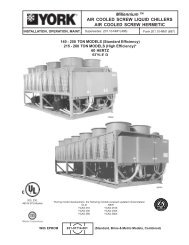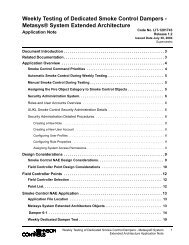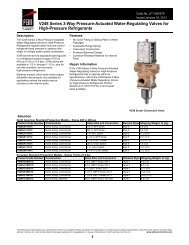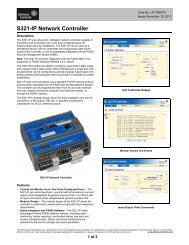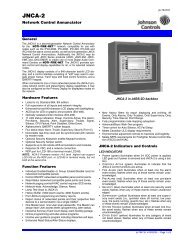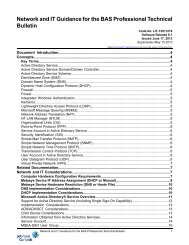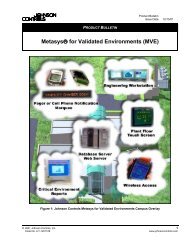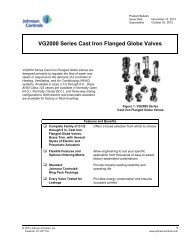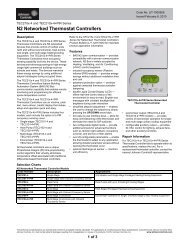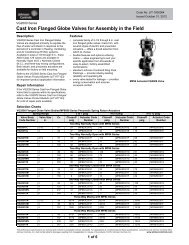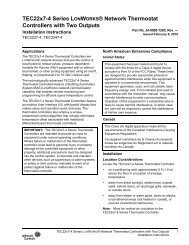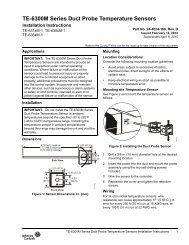TEC Zoning Control System for Stand-Alone and BACnet® MS/TP ...
TEC Zoning Control System for Stand-Alone and BACnet® MS/TP ...
TEC Zoning Control System for Stand-Alone and BACnet® MS/TP ...
- No tags were found...
You also want an ePaper? Increase the reach of your titles
YUMPU automatically turns print PDFs into web optimized ePapers that Google loves.
When the fan output is off (Terminal G), the static pressure control loop is also off<strong>and</strong> the bypass damper is fully open to the 10 VDC output. This conditionminimizes the air pressure related noise during initial fan startup. Be aware that thefan is always on during occupied periods, <strong>and</strong> that it only cycles on dem<strong>and</strong> withthe heating <strong>and</strong> cooling stages during unoccupied periods.When the fan output is on (Terminal G), the static pressure control loop is enabled<strong>and</strong> the bypass damper modulates to maintain the desired static pressure setpointbased on the static pressure input reading at the rooftop controller. Use the ManualScroll Display feature at the rooftop controller to locate the Pressure parameter<strong>and</strong> determine the current static pressure value.Sequence of Operation<strong>TEC</strong>2647Z-2 <strong>and</strong> <strong>TEC</strong>2647Z-2+PIR Zone <strong>Control</strong>lersThe sequence of operation is determined by the Johnson <strong>Control</strong>s<strong>TEC</strong>2664Z-2 Rooftop <strong>Control</strong>ler mode <strong>and</strong> the configuration parameterspreselected <strong>for</strong> the zone controller; see <strong>TEC</strong>2664Z-2 Rooftop <strong>Control</strong>ler on page43 <strong>for</strong> more in<strong>for</strong>mation. See Figure 7 through Figure 16 <strong>for</strong> sequence of operationexamples.PIR Occupancy Sensor OperationThe zone controller is available with or without a factory-installed PIR occupancysensor cover. A zone controller equipped with the PIR occupancy sensor coverprovides advanced active occupancy logic that automatically switches occupancylevels from occupied to st<strong>and</strong>by as required, when motion is sensed. This featureresults in incremental energy savings during scheduled occupied periods when thespace is unoccupied. This allows zones, such as conference rooms <strong>and</strong> storagerooms, that are infrequently occupied to use relaxed setpoints during most of theiroccupied period when the space is not being used.The aim of using a st<strong>and</strong>by setpoint is to have the system recover fairly quicklybetween the st<strong>and</strong>by <strong>and</strong> occupied setpoints when motion is detected in the zone.The relaxed value of the st<strong>and</strong>by setpoint must be far enough from the occupiedsetpoint to warrant the energy savings of a PIR occupancy sensor coverinstallation, but close enough <strong>for</strong> the system to recover quickly to ensureoccupancy com<strong>for</strong>t.To enable the advanced occupancy logic, the following must be set at the zonecontroller:• If a local PIR occupancy sensor cover is installed, the PIR Func parametermust be set to on.• If a remote PIR occupancy sensor is attached to BI1, the BI1 parameter mustbe set to MotionNO or MotionNC.42<strong>TEC</strong> <strong>Zoning</strong> <strong>Control</strong> <strong>System</strong> <strong>for</strong> <strong>St<strong>and</strong></strong>-<strong>Alone</strong> <strong>and</strong> <strong>BACnet®</strong> <strong>MS</strong>/<strong>TP</strong> Networked ApplicationsTechnical Bulletin



